I would urge you to read this essay by Dominican Father Thomas Joseph White. It is worth the read because it is a reasoned argument with pastoral sense.
I would urge you to read this essay by Dominican Father Thomas Joseph White. It is worth the read because it is a reasoned argument with pastoral sense.
O my Lord, you only are our King; help me, who am alone and have no helper but you, for my danger is at hand. . . .You, O Lord, did take Israel out of all the nations. . .for an everlasting inheritance. . . .And now we have sinned before you, and you have given us into the hands of our enemies, because we glorified their gods. You are righteous, O Lord! . . .Remember, O Lord; make yourself known in this time of affliction and give me courage. (Esther 14:3-7)
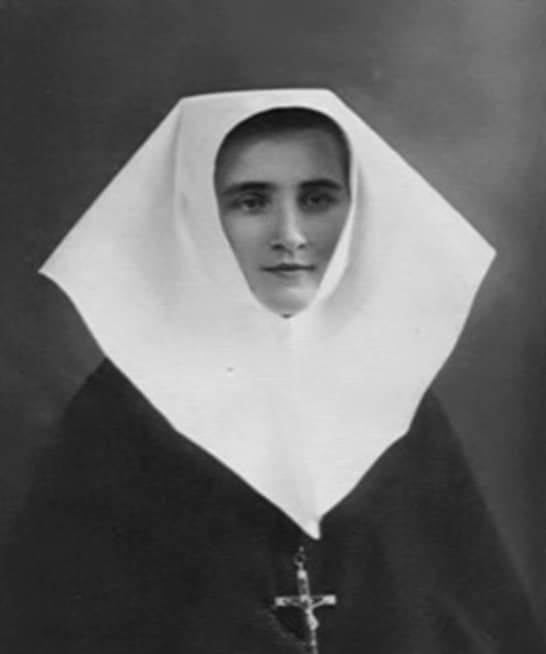 On the liturgical calendar of the Church in Poland today is Blessed Celestyna Faron, IHM (1913 – 1942) a Religious Sister of the Congregation of the Little Sister Servants of the Immaculate Conception. Within the Congregation she served variously as a teacher and catechist. In history she was known as Katarzyna Stanisława Faron 24 April 1913 born in Zabrzez, Malopolskie, [southern] Poland and died on Easter morning, 9 April 1944 in the Auschwitz concentration camp.
On the liturgical calendar of the Church in Poland today is Blessed Celestyna Faron, IHM (1913 – 1942) a Religious Sister of the Congregation of the Little Sister Servants of the Immaculate Conception. Within the Congregation she served variously as a teacher and catechist. In history she was known as Katarzyna Stanisława Faron 24 April 1913 born in Zabrzez, Malopolskie, [southern] Poland and died on Easter morning, 9 April 1944 in the Auschwitz concentration camp.
Blessed Celestyna’s biography reveals that before her first profession of vows, she wrote to the Mother General saying, “Through my vows I long to belong entirely to Jesus Christ as a total sacrificial offering. I always desire to walk the way of love and devotion so that I can approach the Immaculate Lamb.”
Faron is remembered for her charity and courage, even in the face of death. She was beatified by Pope John Paul II with other 107 other Polish Martyrs of World War II on 13 June 1999. The collective feast day of the martyrs is 12 June.
The Little Sister Servants of the Immaculate Conception published this brief reflection on Blessed Celestyna AND there is this biographical note on the Blessed which includes some witnesses on the Blessed making her person better known.
I didn’t know about Blessed Celestyna until this morning when my friend Bill brought her to my attention.
As a side note, the Little Sister Servants of the Immaculate Conception (USA) have several witnesses of holiness from their ranks: 5 sisters who cause for canonization is being studied, in addition to the founder Blessed Edmund Bojanowski and Blessed Celestyna. Let’s pray for Edmund and Celestyna’s canonization.
May Blessed Celestyna intercede for us before the Throne of Grace asking for the gifts of charity, courage, poverty of spirit and the ability to sacrifice ourselves for the Lord of Life. Blessed Celestyna, pray for us.
 Whenever we try to rigidly define an experience or a call we often come up short. Words fail and sometimes a little confusion enters into our awareness. These days I am reading in the School of Community (the weekly catechesis of Communion and Liberation) Luigi Giussani’s Generating Traces in the History of the World (2010) and there he writes of Baptism’s character: the birth of a new creature. This particular section is quite good and hopeful. Giussani reminds us that beginning with Christ we have baptism leading to a companionship. Noting what Paul VI said (realize that Paul was formerly Giussani’s bishop in Milan) that with Baptism we become a “People that make history” and in another place he says we are a “new people who make history…” The event of Baptism “implies the participation of my person in the Mystery of Christ’s person –my person is incorporated into the Mystery of Christ’s person.”
Whenever we try to rigidly define an experience or a call we often come up short. Words fail and sometimes a little confusion enters into our awareness. These days I am reading in the School of Community (the weekly catechesis of Communion and Liberation) Luigi Giussani’s Generating Traces in the History of the World (2010) and there he writes of Baptism’s character: the birth of a new creature. This particular section is quite good and hopeful. Giussani reminds us that beginning with Christ we have baptism leading to a companionship. Noting what Paul VI said (realize that Paul was formerly Giussani’s bishop in Milan) that with Baptism we become a “People that make history” and in another place he says we are a “new people who make history…” The event of Baptism “implies the participation of my person in the Mystery of Christ’s person –my person is incorporated into the Mystery of Christ’s person.”
Coupled with St John Henry Newman’s teaching that each of us given a mission, a work that is non-transferable and unique to each person, I was thinking of the Oblate vocation and the following paragraph came to mind on place of oblates in the witness of the Benedictine monastery. Several years ago, the English Benedictines formed their thinking of how to understand the vocation of the laity in relation to monastic way of life.
“Lay oblates are a particular way in which a monastic community is able to share the fraternal communion of its life with lay people who seek to leaven the dough of their ordinary lives and their service of the mission of the local church with the yeast of Benedictine wisdom. They have responded to a call, been through a process of discernment and formation, and have made a promise to witness to Benedictine life in their homes, at work and in the local church. The part that oblates play in the individual communities where they make their oblation varies, but the mutual witness of prayer and the sharing of the testimony of lives that look to the Rule to support them is an encouragement to the monastic communities, and is a sign of the vitality of Benedictine life in the local churches.”
Excerpt from TO PREFER NOTHING TO CHRIST, paragraph 116
The Monastic Mission of the English Benedictine Congregation
The Catholic Truth Society, Publishers to the Holy See, London 2015
Given that we are at the beginning of Holy Week –a week that has changed all of human history– and that we are dealing with the drama of the Coronavirus, we need a word of hope at this time of challenge. It’s important to attend to the words of a cloistered nun because she is at the heart of humanity and the heart of the Church.
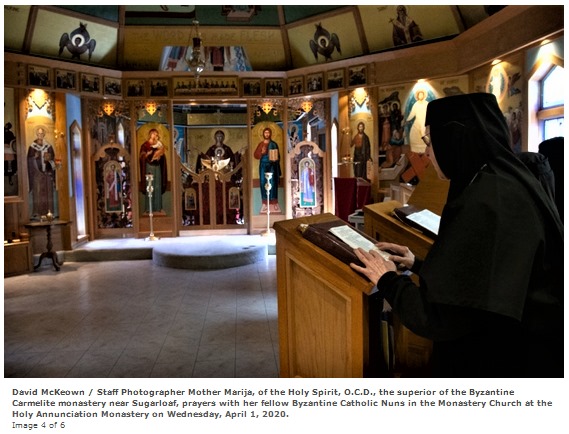 All this in mind, John E. Usalis wrote a piece for today for The Republican Herald, “Fearing isolation? Byzantine nun offers advice from life in cloister” with David McKeown as photographer. They did a good job bringing to life some good ideas from Mother Marija, the Mother Superior of a monastery unknown to many in the USA. The Holy Annunciation Monastery (Sugarloaf, PA) is rather unique place as the nuns adhere to the Byzantine Liturgy, theology and spiritual disciplines and they belonged until recently to the Washington Province of Carmelites. Now they are in process of moving to a monastic way of life that is closer to the Eastern ethos (dependent on the bishop) while following the Rule of St. Benedict, and other historic monastic rules.) So, the article is a bit confused as to the exact details of the life. The nuns are working on a clear line of communication.
All this in mind, John E. Usalis wrote a piece for today for The Republican Herald, “Fearing isolation? Byzantine nun offers advice from life in cloister” with David McKeown as photographer. They did a good job bringing to life some good ideas from Mother Marija, the Mother Superior of a monastery unknown to many in the USA. The Holy Annunciation Monastery (Sugarloaf, PA) is rather unique place as the nuns adhere to the Byzantine Liturgy, theology and spiritual disciplines and they belonged until recently to the Washington Province of Carmelites. Now they are in process of moving to a monastic way of life that is closer to the Eastern ethos (dependent on the bishop) while following the Rule of St. Benedict, and other historic monastic rules.) So, the article is a bit confused as to the exact details of the life. The nuns are working on a clear line of communication.
Self-distancing and isolation in these trying times of the coronavirus is a difficult adjustment for many.
For an order of religious women in Luzerne County, however, it is their lifestyle.
Holy Annunciation Monastery near Sugarloaf is home to the Byzantine Discalced Carmelites, a religious order that follows the Monastic Rule of St. Benedict. The monastery is part of the Ruthenian Byzantine Eparchy of Passaic, New Jersey.
The 12 nuns in the monastery live a cloistered life, which means they are strictly separated from the affairs of the outside world. Once they profess their solemn vows, they live apart from society, free of distractions and immersed in a life of prayer “for the good of the world,” according to “A Nun’s Life” website.
 Ninety- year- old Mother Marija of the Holy Spirit, one of the three founding nuns when the monastery was inaugurated on Feb. 23, 1977, is the monastery’s superior. Father Walter J. Ciszek, S. J., whose cause for canonization in the Catholic Church is being investigated, played an important part in the monastery’s founding.
Ninety- year- old Mother Marija of the Holy Spirit, one of the three founding nuns when the monastery was inaugurated on Feb. 23, 1977, is the monastery’s superior. Father Walter J. Ciszek, S. J., whose cause for canonization in the Catholic Church is being investigated, played an important part in the monastery’s founding.
Mother Marija has been a Carmelite nun for 74 years, the first 30 years in the Roman Catholic rite. “Patience obtains everything,” she said. “There’s not much difference here.”
‘It’s about growth’
Entering the order currently allows for a much slower adaptation of oneself in living a cloistered life.
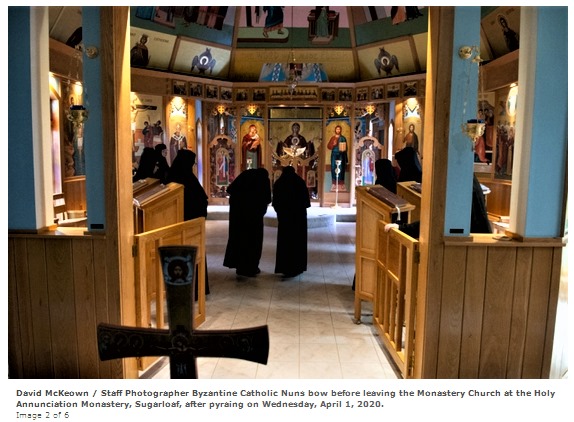 “It was very, very strict; very rigid. For 20 years I never saw the front door,” Mother Marija said. “What I did in six months postulancy, now we take two years observership and two years postulancy. So now instead of six months, it’s four years. That is so the person can grow. In my day, you were processed. Now, it’s about growth.”
“It was very, very strict; very rigid. For 20 years I never saw the front door,” Mother Marija said. “What I did in six months postulancy, now we take two years observership and two years postulancy. So now instead of six months, it’s four years. That is so the person can grow. In my day, you were processed. Now, it’s about growth.”
She said adapting to a more closed- in condition can depend on each person’s personality.
“Some people are predisposed to a certain amount of solitude, who are the introverts,” she said. “There are also the extroverts. They’re great neighbors, but not always such great people in the house. Their neighbors enjoy them more than their family members do.”
She said it’s important for those entering the cloister to see “where our gifts are,” and find balance.
“You identify how God made you. That’s a big thing,” she said.
“I tell the sisters that when you get to heaven, you’re all a bunch of cakes, but are you an angel cake, a chocolate cake, a pound cake? God will put into your life what is needed in your recipe.
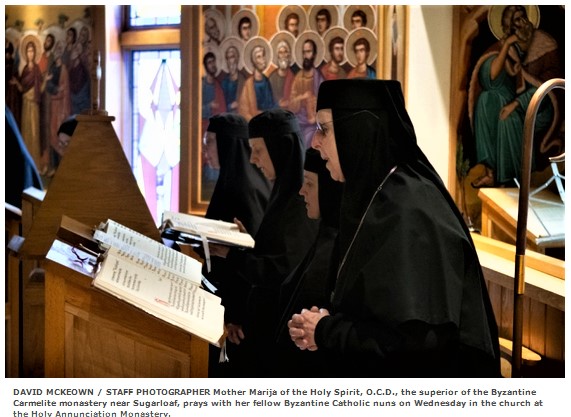 “I don’t think enough of us — and it took me a long time — realize that before we were made, God knew exactly what he wanted of us,” she added.
“I don’t think enough of us — and it took me a long time — realize that before we were made, God knew exactly what he wanted of us,” she added.
Hope, love, truth
Mother Marija offered tips for living a self- distancing life through its religious aspects.
“The first thing is, you have to have hope. We all have to know where we’re going. You always have a destination. If you’re making something, you need to have an idea of what’s next,” she said. “You just don’t leave aimlessly.”
The second thing is to believe one is loved.
“That has to be an experience that is already there. We should be so kind to other people. Mother Teresa wanted for everyone to feel before they died in the Hindu culture of untouchables that that person was loved. That gives you value. You have to have love and faith and prayer working interchangeably.”
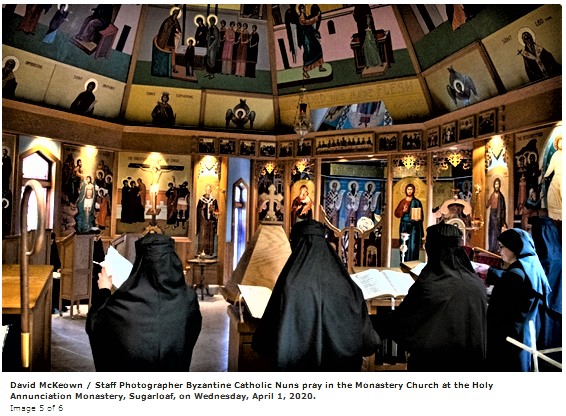 Looking for the truth in a situation is also necessary.
Looking for the truth in a situation is also necessary.
“That means that we’re not too sure of ourselves,” she said. “There needs to be an area of self- doubt, a trust in someone else’s opinion and the readiness to communicate.”
Thinking of others beyond oneself is also an important condition.
“When you’re young, up until 21, you think of the success of yourself. You have to develop your own potential,” she said. “But from 30 on, make a success of someone else.
Holy Annunciation Monastery
403 West County Road
Sugarloaf, PA 18249
570-788-1205
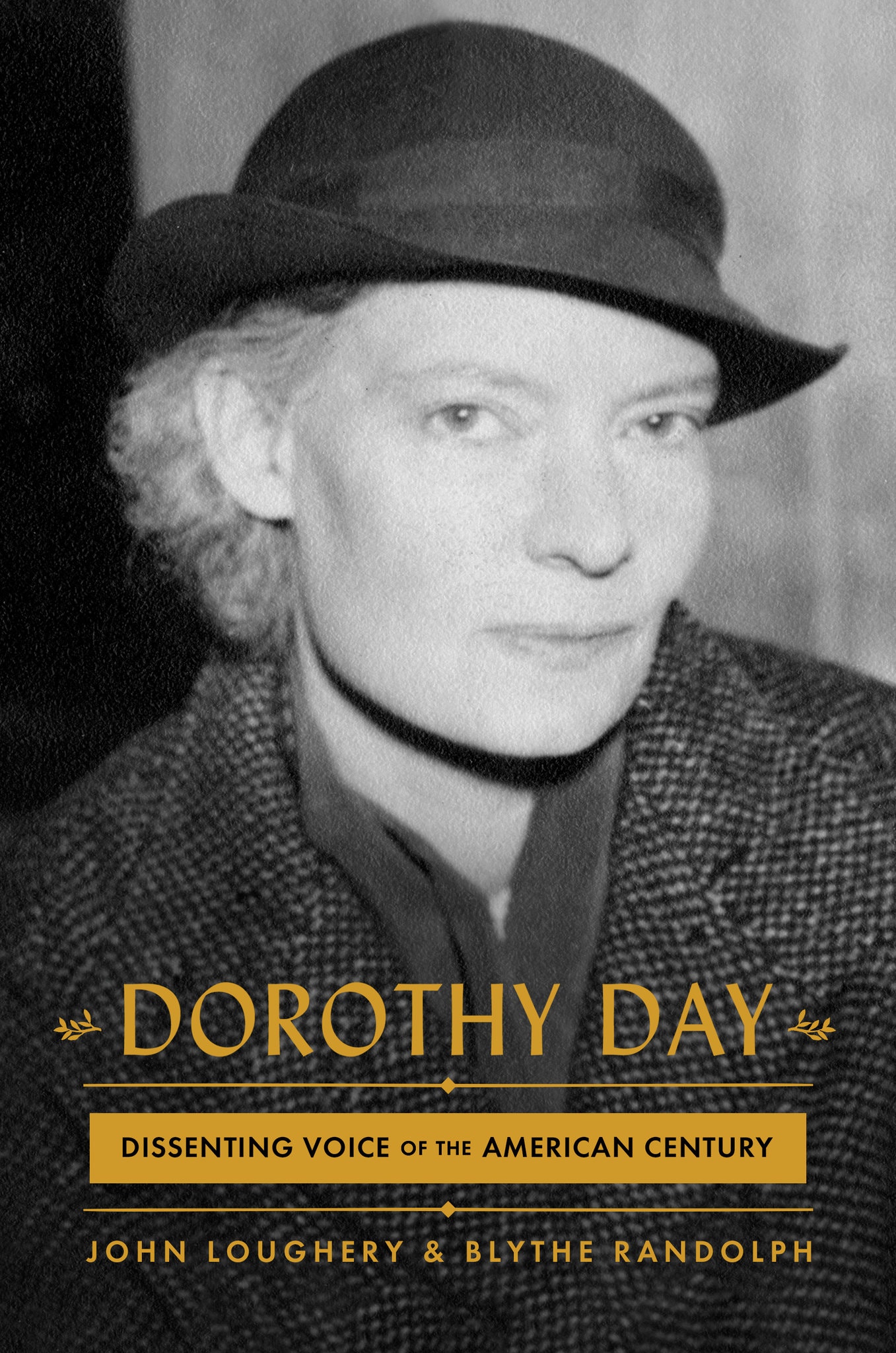 The Servant of God Dorothy Day has a new critical biography penned by accomplished biographers John Loughery and Blythe Randolph. According to the NYTimes review of the book, the authors viewed their subject as “challenging and complex.” Dorothy Day: Dissenting Voice of the American Century is a portrait of Day but it is incorrect to claim that it is the first in 40 years. There are a few other biographies of Dorothy Day published in recent years. I look forward to delving into the Loughery and Randolph volume; my hope is that they did not merely perpetuate the same old cliches. But I doubt it. Already in the review one gets the sense that Day is treated more as a political person than someone who encountered Jesus Christ and desired to live in creative tension and toward the Gospel and the Tradition of the Catholic Church. Terms used to describe Day without due attention to her relationship with Christ and the Mystical Body of Christ are misleading. Happy reading.
The Servant of God Dorothy Day has a new critical biography penned by accomplished biographers John Loughery and Blythe Randolph. According to the NYTimes review of the book, the authors viewed their subject as “challenging and complex.” Dorothy Day: Dissenting Voice of the American Century is a portrait of Day but it is incorrect to claim that it is the first in 40 years. There are a few other biographies of Dorothy Day published in recent years. I look forward to delving into the Loughery and Randolph volume; my hope is that they did not merely perpetuate the same old cliches. But I doubt it. Already in the review one gets the sense that Day is treated more as a political person than someone who encountered Jesus Christ and desired to live in creative tension and toward the Gospel and the Tradition of the Catholic Church. Terms used to describe Day without due attention to her relationship with Christ and the Mystical Body of Christ are misleading. Happy reading.
The review can be read here.
 John was abbot of St Catherine’s on Mt Sinai in the first half of the seventh century. His name derives from his most famous work, called The Ladder to Paradise. Its thirty steps detail a system of monastic spirituality. This manual is the most widely used around the east. His popularity among monastics, the custom of reading his work at the monastery table during Great Lent, and the fact that the calendar feast of St John falls in this season.
John was abbot of St Catherine’s on Mt Sinai in the first half of the seventh century. His name derives from his most famous work, called The Ladder to Paradise. Its thirty steps detail a system of monastic spirituality. This manual is the most widely used around the east. His popularity among monastics, the custom of reading his work at the monastery table during Great Lent, and the fact that the calendar feast of St John falls in this season.
St John is known as the new Moses. So if you want to understand this attribution you have to know the the Book of Exodus. Moses was the holy man of his day, went to the desert for 40 years, the one who spoke with God on Mt Sinai, the one recorded and taught God’s Law (the 10 Commandments) and he is the one who led the people in the walk of liberation from slavery to freedom.
St. John spent forty years in the desert, ascended Mt. Sinai, the same mountain as Moses, brought down the mountain like Moses the tablets of the Law, though John’s “law” is called The Ladder of Divine Ascent, a book that describes how we can ascend to God, like the Ten Commandments. One cannot underestimate the role both Moses and John had in their student’s liberation in Christ. For the Christian the only liberation is known in the Paschal Mystery of the Lord: His life, death, resurrection and ascension, no other path of liberation is the liberation experienced in the sacraments (the Holy Mysteries) of Eucharist and the Confession of sins. Liberation is the newness of life in the Lord of Life and His Church.
In addition to the commemoration today, this 6th century Palestinian father has been given a fixed commemoration on the 4th Sunday of Lent. (NS edited)
St. John, point us to Christ.
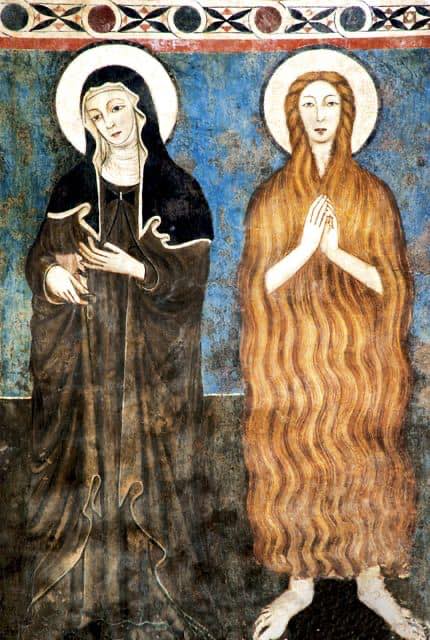 Today, we in the Greek Catholic Churches, honored Mary of Egypt who was a great a sinner; other Byzantine churches on the older calendar will honor her on April 1.
Today, we in the Greek Catholic Churches, honored Mary of Egypt who was a great a sinner; other Byzantine churches on the older calendar will honor her on April 1.
The Canon of St Andrew speaks of the angels being in amazement of her ability to overcome sin and live in grace. Fleeing to the desert she wanted to meet the Living God of mercy and of love. The desert is the place of asceticism and prayer, a place of encounter, a place to give testimony to the ways God continues to create us anew.
In decisive moment she changed her life and went to the hiddenness of the desert. She lived without the sacraments for years. Mary lived a Christian life all the years in the desert without the sacraments in communion with God. Before her death Abba Zosimus brought her the Body and Blood of Christ.
Mary could say that “The word of salvation gently touched the eyes of my heart and revealed to me that it was my unclean life which barred the entrance to me.”
This image of St Clare and St Mary of Egypt is telling for us who living in this period of penance: Great Lent and the Coronavirus. They rejected fear, negativity and sin. Both were spouses of the Lord of Life. It is striking to me that the artist linked both these women saints in art because in reality they represent the virtues, especially purity of heart. They both knew the virtue of being united in prayer, fasting and almsgiving.
Image: Church of Santa Maria Assunta in Vallo di Nera, Perugia, Italy